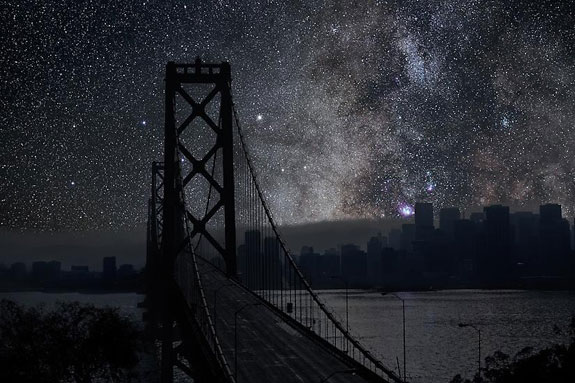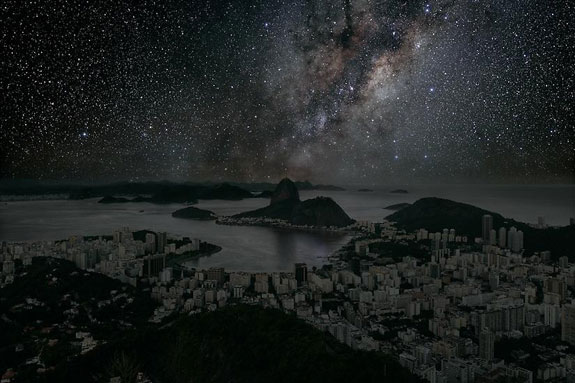URL:http://blogs.smithsonianmag.com/artscience/2013/03/darkened-cities

San Francisco 37° 48′ 30″ N 2010-10-9 Lst 20:58. © Thierry Cohen.
Last week in Collage, I interviewed Caleb Cain Marcus, a New York City-based photographer who spent the last two years documenting glaciers around the world. When he composed his photographs of glaciers in Iceland, New Zealand, Norway and Alaska, Marcus obscured the actual horizon. It was an experiment, he explained, to see how it affected his viewers’ sense of scale.
The idea was born out of the Colorado native’s own experience with city living. “Living in New York City, unless you live very high up, you never see the horizon, which is really kind of odd,” said Marcus. “I’m not sure we are really aware of the effects of not being able to see it.”
In a similar vein, French photographer Thierry Cohen worries about city dwellers not being able to see the starry sky. With light and air pollution plaguing urban areas, it is not as if residents can look up from their streets and roof decks to spot constellations and shooting stars. So, what effect does this have? Cohen fears, as he recently told the New York Times, that the hazy view has spawned a breed of urbanite, sheltered by his and her manmade environs, that “forgets and no longer understands nature.”
Three years ago, Cohen embarked on a grand plan to help remedy this situation. He’d give city dwellers a taste of what they were missing. The photographer crisscrossed the globe photographing cityscapes from Shanghai to Los Angeles to Rio de Janeiro, by day—when cars’ head and taillights and lights shining from the windows of buildings were not a distraction. At each location, Cohen diligently recorded the time, angle, latitude and longitude of the shot. Then, he journeyed to remote deserts and plains at corresponding latitudes, where he pointed his lens to the night sky. For New York, that meant the Black Rock Desert in Nevada. For Hong Kong, the Western Sahara in Africa. For Rio and São Paulo, the Atacama Desert in Chile, and for Cohen’s native Paris, the prairies of northern Montana. Through his own digital photography wizardry, Cohen created seamless composites of his city and skyscapes.

Rio de Janeiro 22° 56′ 42″ S 2011-06-04 Lst 12:34. © Thierry Cohen.
“By traveling to places free from light pollution but situated on precisely the same latitude as his cities (and by pointing his camera at the same angle in each case), he obtains skies which, as the world rotates about its axis, are the very ones visible above the cities a few hours earlier or later,” writes photography critic Francis Hodgson, in an essay featured on Cohen’s Web site. “He shows, in other words, not a fantasy sky as it might be dreamt, but a real one as it should be seen.”
Cohen’s meticulousness pays off. While he could present a clear night sky taken at any latitude, he instead captures the very night sky that, in megacities, is hidden from sight. The photographer keeps some details of his process a secret, it seems. So, I can only suspect that Cohen takes his picture of a city, determines what the night sky looks like in that city on that day and then quickly travels to a remote area to find the same night sky viewed from a different location. This precision makes all the difference. “Photography has always had a very tight relationship to reality,” Hodgson goes on to say. “A good sky is not the right sky. And the right sky in each case has a huge emotional effect.”
It is an emotional effect, after all, that Cohen desires. The photographer wants his “Darkened Cities” series, now on display at Danziger Gallery in New York City, to raise awareness about light pollution. Spoken like a true artist, Cohen told the New YorkTimes, that he wants to show the detached urbanite the stars “to help him dream again.”
“There is an urban mythology which is already old, in which the city teems with energy and illumines everything around it. All roads lead to Rome, we are told. Cohen is telling us the opposite,” writes Hodgson. “It is impossible not to read these pictures the way the artist wants them read: cold, cold cities below, cut off from the seemingly infinite energies above. It’s a powerful reversal, and one very much in tune with a wave of environmental thinking of the moment.”
“Darkened Cities” is on display at Danziger Gallery through May 4, 2013.